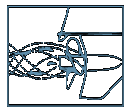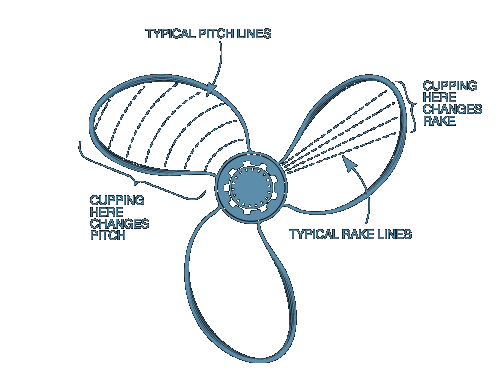|
THRU-HUB EXHAUST PROPELLERS
The thru-hub exhaust propeller design utilizes a round barrel to which the blades are attached. The exhaust gases pass through the lower unit torpedo and exit through this round barrel hub. Advantages of this type of propeller include good planing performance ("hole shot” in propeller language), especially on boats where exhaust induced ventilation needs to be controlled or eliminated. Additionally, all props with this or similar types of underwater exhaust create an effective exhaust noise reduction. |
|
OVER-HUB EXHAUST PROPELLERS
Over-hub propellers eliminate the larger outer barrel, instead attaching the blades directly to the smaller inner cavity surrounding the propeller shaft. This results in massive exhaust flooding the prop during takeoff, with characteristically high rpm's for the first few seconds of planing. Typically used on applications designed for maximum speed. |
|
OVER/THRU-HUB EXHAUST PROPELLERS
This type of design is normally used when the desired degree of exhaust flooding at takeoff is more than is readily obtainable with thru-hub exhaust, but less than that inherent in the true over-hub design. Additionally, the superior strength of the thru-hub design (shorter blade length means less leverage force on impacts) is retained. |
|
PROPELLER CUP
Cup assists in increasing the water gripping capability of the propeller, particularly on boats with elevated motor heights and high trim angles. Cup can also provide additional bow lift when utilized on the rake line of the prop. Applying cup to the trailing edge of the prop along the pitch line will increase the effective pitch of the propeller. A standard cup will typically result in a decrease of 200 to 400 rpm's. This usually means a decrease in pitch of 1 to 2 inches is required to run a cupped propeller in place of an uncapped wheel. |
|
CONSTANT PITCH vs. PROGRESSIVE PITCH
Constant pitch propellers have a constant pitch across the entire propeller high-pressure face. Progressive pitch propellers have a lower pitch at the leading edge, which increases progressively across the blade face. This type of propeller typically provides superior planing performance. |
BLADE RAKE
Blade Rake represents the angle of attachment of the blade to the hub of the propeller. This is not to be confused with the pitch, which is a measure of the twist or screw progression. Higher rake normally improves performance in ventilating or cavitating situations (high engine elevations and high trim angles). Additionally, higher rake can provide higher bow lift, which will frequently improve speed. Low rake blades are typically used on motors with propellers running fully submerged, typically carrying moderate to heavy loads. The rake angle can either be straight or the average angle of a parabolic curve.
Blade Rake represents the angle of attachment of the blade to the hub of the propeller. This is not to be confused with the pitch, which is a measure of the twist or screw progression. Higher rake normally improves performance in ventilating or cavitating situations (high engine elevations and high trim angles). Additionally, higher rake can provide higher bow lift, which will frequently improve speed. Low rake blades are typically used on motors with propellers running fully submerged, typically carrying moderate to heavy loads. The rake angle can either be straight or the average angle of a parabolic curve.








